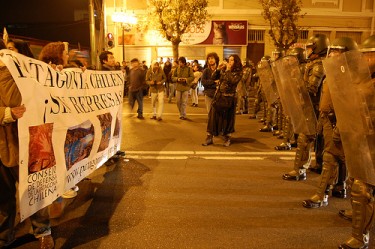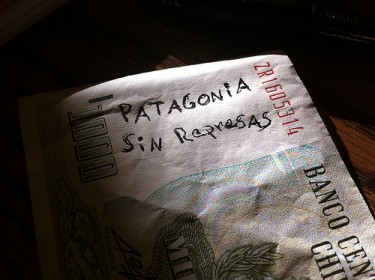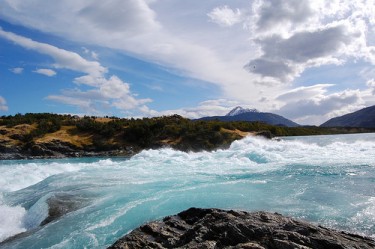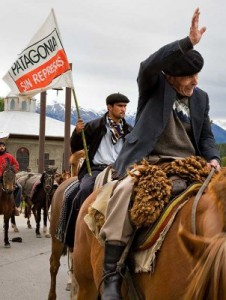On Monday, May 9, the Environmental Evaluation Commission, meeting in Coyhaique, a city in the Chilean Patagonia, and composed of 12 appointed officials in President Sebastian Pinera's government, approved the hydroelectric plant Hidroaysen, [es] a merger between Spanish-Italian Endesa and the Chilean Colbun.
The project includes the construction and operation of 5 dams, two in Baker River and three in Pascua River located in the Aisén region in the remote south of Patagonia, Chile and it has an estimated value of 3.2 billion worth of investments.
This video tells us a little about what the project is about:
Video: Hidroaysen is a hydroelectric project that will build and operate five dams in the Chilean Patagonia, two in the Baker River and three in de Pascua River, flooding 5910 hectares equivalent to the surface of the Manhattan Island in New York. To provide energy to Santiago and new mining projects in the north of the country, Hidroaysen is looking to install 3800 towers, each 60 mts. tall, along 2000 kms. becoming the most lengthy electric wiring in the world. It would join the interconnected central system at the Lo Prado Bridge, thus going through half of one of the longest countries in the world.
The project was approved by 11 votes in favour and one against in the midst of a tense atmosphere marked by a protest of about 1,000 people outside the Coyhaique City Hall, where the voting took place.
Pese a las 11 mil observaciones ciudadanas presentadas, las denuncias de que informes de los organismos técnicos que revisaron el proyecto fueron cambiados y la inhabilidad de cuatro ministerios, el apoyo explícito del gobierno de Sebastián Piñera y de los medios masivos, fue aprobado en medio de un fuerte contingente policial el proyecto de Hidroaysén. […]
According to the observations of the online chilean news site El Ciudadano [es].
To which the site radio.uchile.cl [es] added:
La iniciativa energética estaba altamente cuestionada por una serie de irregularidades que se presentaron durante su tramitación como cambios sorpresivos y sin fundamento de los servicios técnicos. Sus detractores además denunciaron un sistemático lobby de las empresas Endesa y Colbún respaldado por el Gobierno para presionar por la aprobación de este proyecto.”
The “for” and “against” stances vary in reasoning. However, the majority of the population is against the construction. On Twitter, the Carbon footprint consultancy @carboambiente commented:
Encuestas online indican que #NOaHidroaysen:@Emol 53%;@laterceracom 66%;@nacioncl 79%; @PublimetroChile 81% que más quieren!!!
Tomas Mosciatti, journalist from Bio Bio Radio explains the reasons for rejecting the Hydroaysen project to CNN Chile:
http://www.youtube.com/watch?v=Ruls0enMHvE&feature=player_embedded
Video: Tomas Masciatti professes that in his personal opinion, besides it not being environmentally friendly to proceed with this project, there are also very important considerations that were not taken before going ahead with what he calls the biggest project ever undertaken in Chile. He outlines the fact that Chile has no energy policy, that things have not been put in place when taxation, the cable system or consumer's rights are concerned. He also stresses that Chile is not facing such a grave energy crisis to have to resort to making a decision so quickly as this one was made.
He also mentions political implications, such as Chile producing a surplus of energy (and contamination) to be later sold to Argentina. Other problems he says are corruption within the authorities, imperialism and a monopoly created when Hydroaysen rules the energy sector with a whopping 80% production in the entire market. Masciatti says that the residents of Aysen will get no benefit whatsoever from this project since all the energy will be channeled to Santiago, plus they will pay the same rates as the people of Santiago, which isn't fair to them at all.
There have been various publications that contain the disapproval of the project. Among them, there is an ecological group called Verdeseo that published “7 Reasons for a Patagonia without Dams” [es]. Also, Pablo Astudillo of online community El Quinto Poder, wrote “7 Reflections before the eventual approval or rejection of the Hydroaysen” [es], which says, in a nutshell:
1. La hidroelectricidad NO es energía limpia.
2. Duplicar la energía no ayuda a superar la pobreza.
3. Duplicar la energía tampoco asegura el bienestar económico.
4. Las energías renovables no convencionales (ERNC) sí son una opción.
5. Las represas no garantizan energía más barata.
6. La legislación ambiental es deficiente.
7. La ciudadanía no recibe información suficiente sobre los efectos negativos de los proyectos eléctricos.
2. Doubling energy production will not help reduce poverty.
3. Nor will it secure economic security.
4. Non-conventional renewable energy is an option.
5. Dams don't guarantee cheap energy.
6. Environmental policy is lacking.
7. The public does not get enough information about the negative effects that these energy projects may have.
As for the arguments in favour, the company's site mentions [es]:
1. La energía de Hidroaysén es limpia y renovable.
2. Evita la construcción de termoeléctricas.
3. No impacta al turismo
4. Generará empleo y acciones positivas de responsabilidad social en la comunidad.
2. The construction of thermal power stations is avoided.
3. It doesn't impact tourism.
4. It will create employment and general social responsibility in the community.
On the other hand, Sebastian Jordana of Platforma Urbana states in his analysis of pros and cons in a post titled,”Hydroaysen a necessary evil?” [es]:
Todos saben que daños va a hacer, entonces, ¿para qué construir semejante proyecto? La demanda energética incrementa todos los años, y por ende, la oferta debe aumentar también. Se estima que de aquí a 10 años más, Chile no podrá cumplir con esta demanda, por lo que nuevas formas de producir energía son necesarias. Los detractores de Hidroaysén hablan de otras formas de producir energía, lo cierto es que la hidráulica es limpia y rendidora. Por ejemplo, para producir 360 MW de energía se necesitan aproximadamente 25.000 hectáreas de energía solar, 15.000 de energía eólica y solamente 3.600 de energía hidráulica.
Activist, blogger and Global Voices author Felipe Cordero (@felipe_cordero) summarized the detractors’ stance in a tweet:
Nadie dice que #hidroaysen no usa energía renovable. Lo renovable ahi es el agua, pero la inundación y el cableado es el problema
Social media reactions appeared quickly after the project was approved. The tweets made against the government and the project propelled at such a speed making the hashtag #nohydroaysen a trending topic for the entire day on May 9. Also, a call to protest onthe streets was made in all the country. An estimated 10,000 people reacted to this call, according to the online journal El Dinamo [es].
Carolina Santander (@carolinasantan) lamented:
Con mucha rabia, pena y verguenza, estos politicos (todos) son unos vendidos sin escrupulos. #NOAHIDROAYSEN
Travesia La Bermudez (@Kaxorras_Mal) noted:
Porque la gran mayoría de los chilenos queremos una #PATAGONIASINREPRESAS! #NOAHIDROAYSEN //RT!
Actress Leanor Varela (@leonorvarela) also wrote:
Tengo estómago tomado por estar tan lejos.Prefería estar ahí con uds como la ultima vez. Aguante los q salieron a las calles! #noahydroaysen
However, these demonstrations were repressed by Chilean police throwing tear gas and water at protesters, and apprehending 63 people in Santiago alone, according to a report from newspaper El Mercurio [es] in it's online version. According to radio Cooperativa, “The protest was a gathering of 7000 people in Plaza Italia but the Chilean gendarme dissolved the crowd with three water launchers and two gas launchers. […] The protests were repeated in cities like Coyhaique in front of the Environmental Evaluation Commission- Concepcion, Temuco, Valparaiso and Valdivia, where the police dispersed tear gas on a protest of about 500 people. ” The Facebook page for El Quinto Poder gathered images and testimonies of the protesters throughout Chile.

March against Hidroaysén in Santiago, Chile May 9, 2011. Image by Flickr user jorgeparedes (CC BY-NC 2.0)
Andres Araos (@andresaraos) commented:
19:00 empieza protesta en plaza italia; 19:05 empiezan a llover bombas labrimogenas… represion pura en contra de la libre expresion
Publicist Ivonne Cubillos (@ivocubillos) observed:
la marcha de plaza italia no pudo ser marcha, lacrimógenas y el guanaco la detuvieron, que linda democracia!!!
The force used by the police against protesters was denounced by politicians as well as by the media, and even the General of the gendarme was called upon to testify about the “abuse” [es] (reported by El Mercurio online)
On the other hand, blogger Tomas Bradanovic posted the following comment against the protests with the title “Patagonia with Dams” [es]:
Los seres humanos tenemos una tendencia irresistible a seguir las modas y ahora que hay más comunicación es fácil masificarlas. Hoy está de moda ser “ambientalista” lo que es una catástrofe para el medio ambiente que lo que menos necesita son militantes tontos y manipulables […]
Daniel Fernandez, executive vice-president of Hydroaysen, also expressed his distaste for the protests in an interview [es]with the online journal El Dinamo, dismissing the citizen resistance as a pitfall for the project just as with Barrancones [es] saying “100 Twitter users isn't a whole community.”
As far as the dissident voices, the protests have only just begun. There have been many other calls to take the streets on the 13th and 23rd of May. The leader of the protestsPatagonia Sin Represas [es] (Patagonia without Dams), has started an online petition and will take the battle to a legal level. In an interview with radio Bio-Bio [es], attorney Marcelo Castillo of Patagonia sin Represas announced with an animated regret that the new battle is starting, that about 20 such judicial, administrative as well as penal resources have all united against Hydroaysen.
Additionally, the director of Greenpeace Chile [es], Matias Asun, criticised the historical responsibility of political representatives of the country in recent years in the same radio station, saying that they have not taken the issue of the environment seriously.
Unlike the 90's, now social media and online communities have helped sensitise people about the repercussions of energy projects, just like with Barrancones in Punta de Chorros [es], canceled thanks to activism, and now Hydroaysen in the Aysen region. Information and open discussion have raised the voice of the people concerning their opinions on these developments, so that projects that were easily approved before now come under everyone's scrutiny.

1000 Chilean pesos bill with the phrase "Patagonia Without Dams". Image by Flickr user soy elOjo (CC BY-NC-SA 2.0)









10 comments
I heard about the HidroAysen protest in today’s LA Times article and I am also against this project and many other dam building schemes because of the tremendous damage they do to a river’s ecosystem. In the United States, our own Columbia River drainage is a perfect example of man’s short sighted misuse of resources in the building of the infamous Bonneville Dam system which prevents wild salmon from returning to their breeding grounds. Some of the negative impacts are: loss of nutrients from dying salmon, silt buildup, poorer water quality, erosion, loss of habitat and relocation of people. According to the newpaper, Pinera is being pushed by the mining companies involved, so we know the interests of a few are behind this project. Is it worth risking the loss of wild fish, animals and the people dependent on free flowing rivers like the Baker and Pascua rivers? Here’s the web link if you are interested in seeing the fate of our once mighty Columbia River salmon runs.
See http://video.pbs.org/video/1891112523
Thank you for your contribution Scott! It is quite informative and it pleases me to know that you recognise the implications of this situation and speak up about it. I hope that the message spreads, just as it got to you.
You’re welcome. For additional information on pros and cons see http://en.wikipedia.org/wiki/Hydroelectricity#Advantages_and_disadvantages_of_hydroelectricity. In particular, the article mentions dams produce of methane, a greenhouse gas. Isn’t it sad to convert the “lungs of our earth” to another source of global warming?